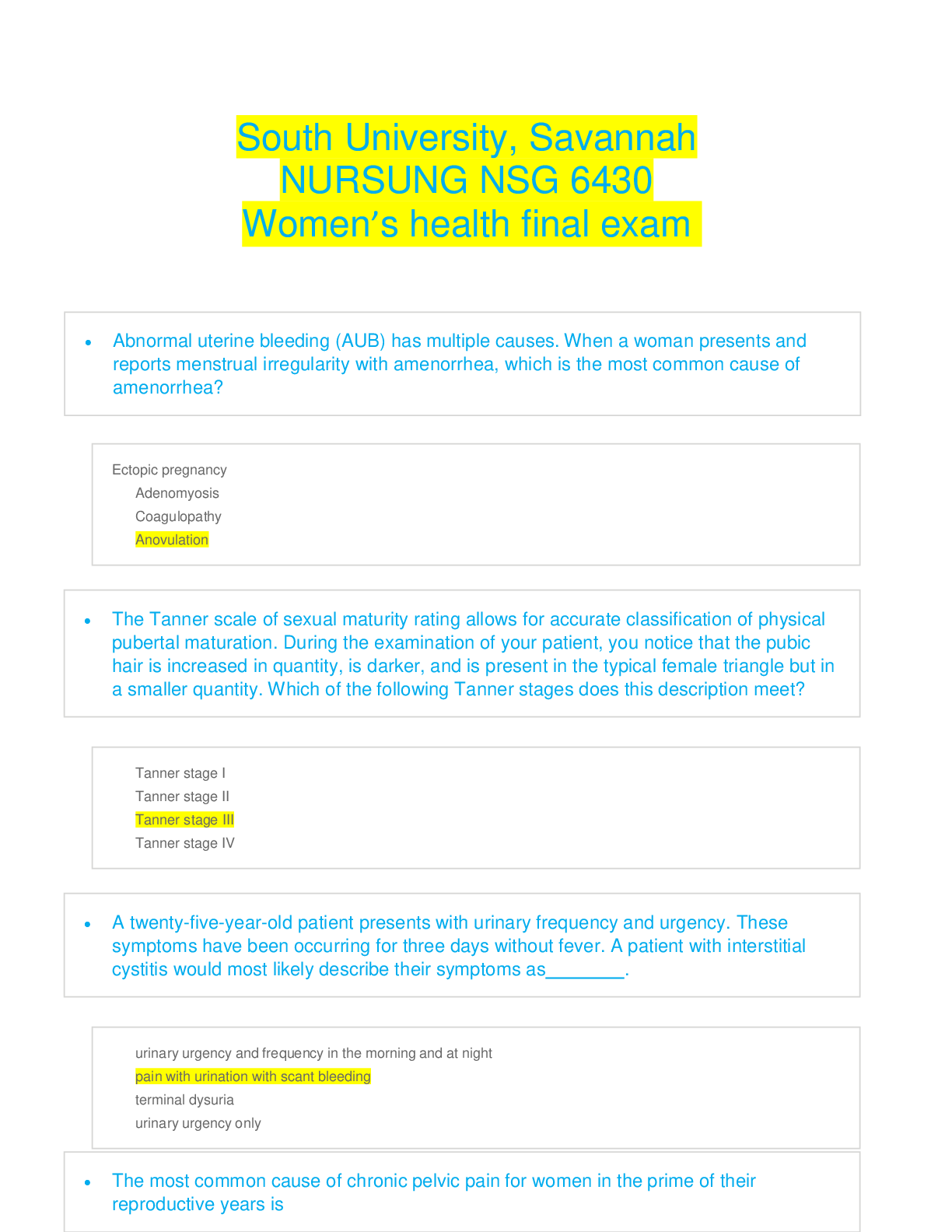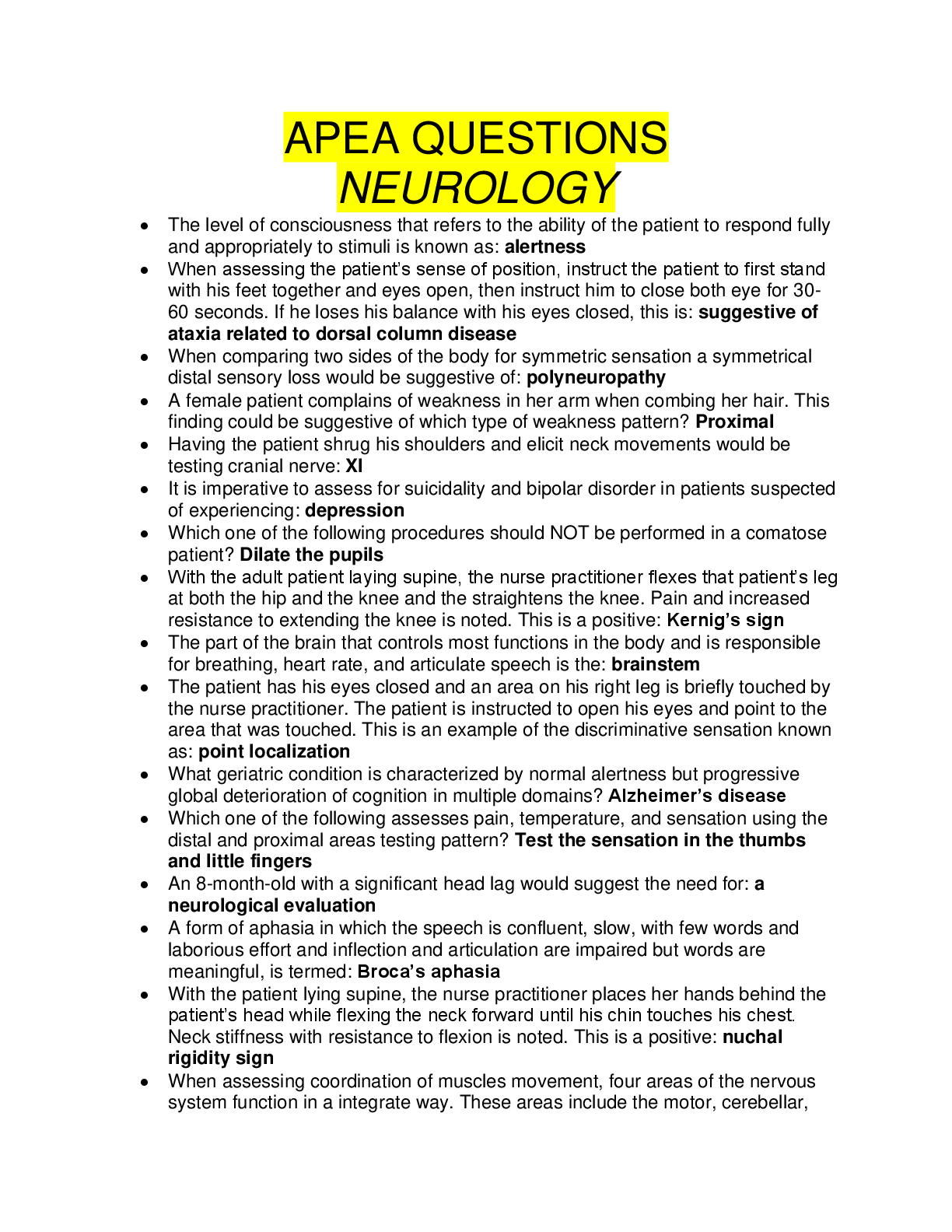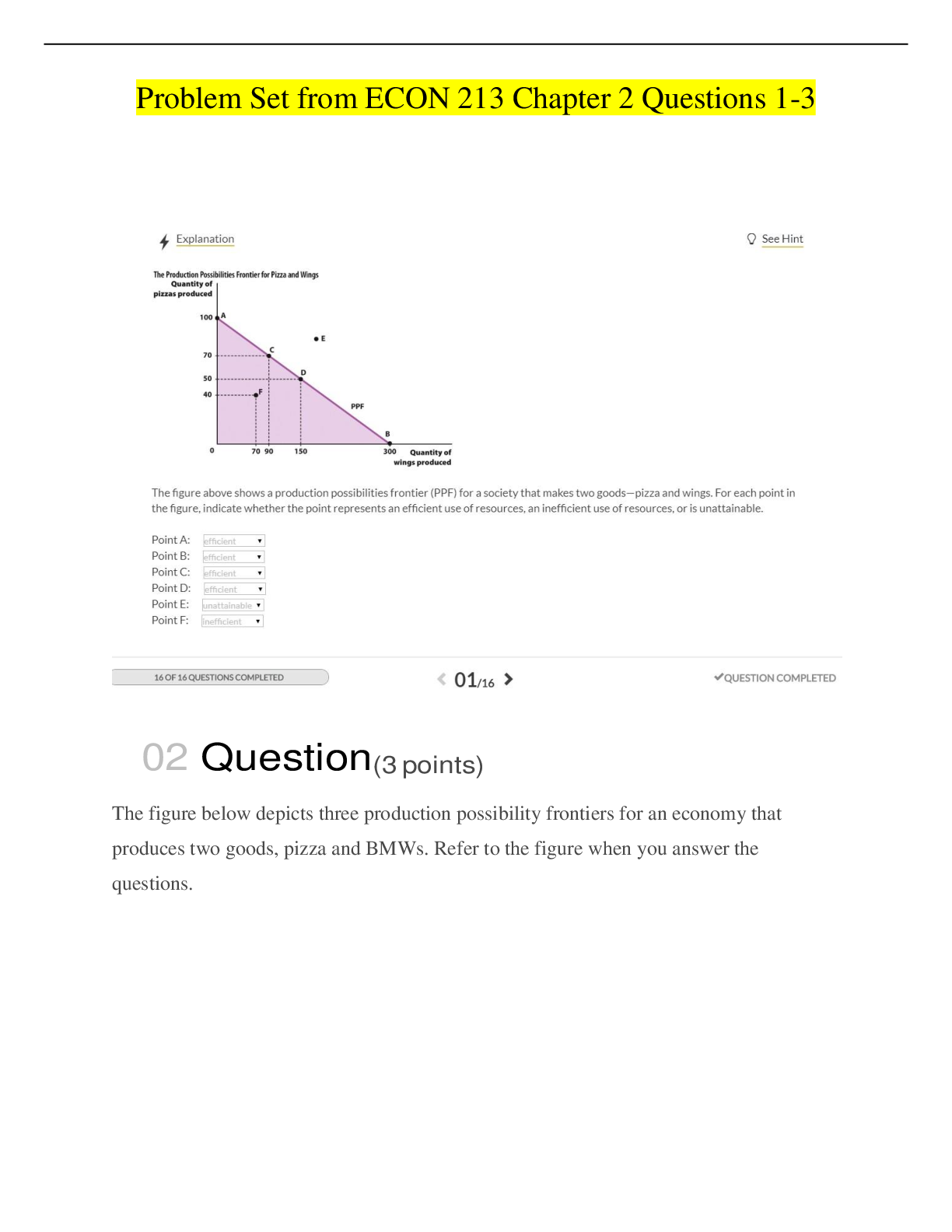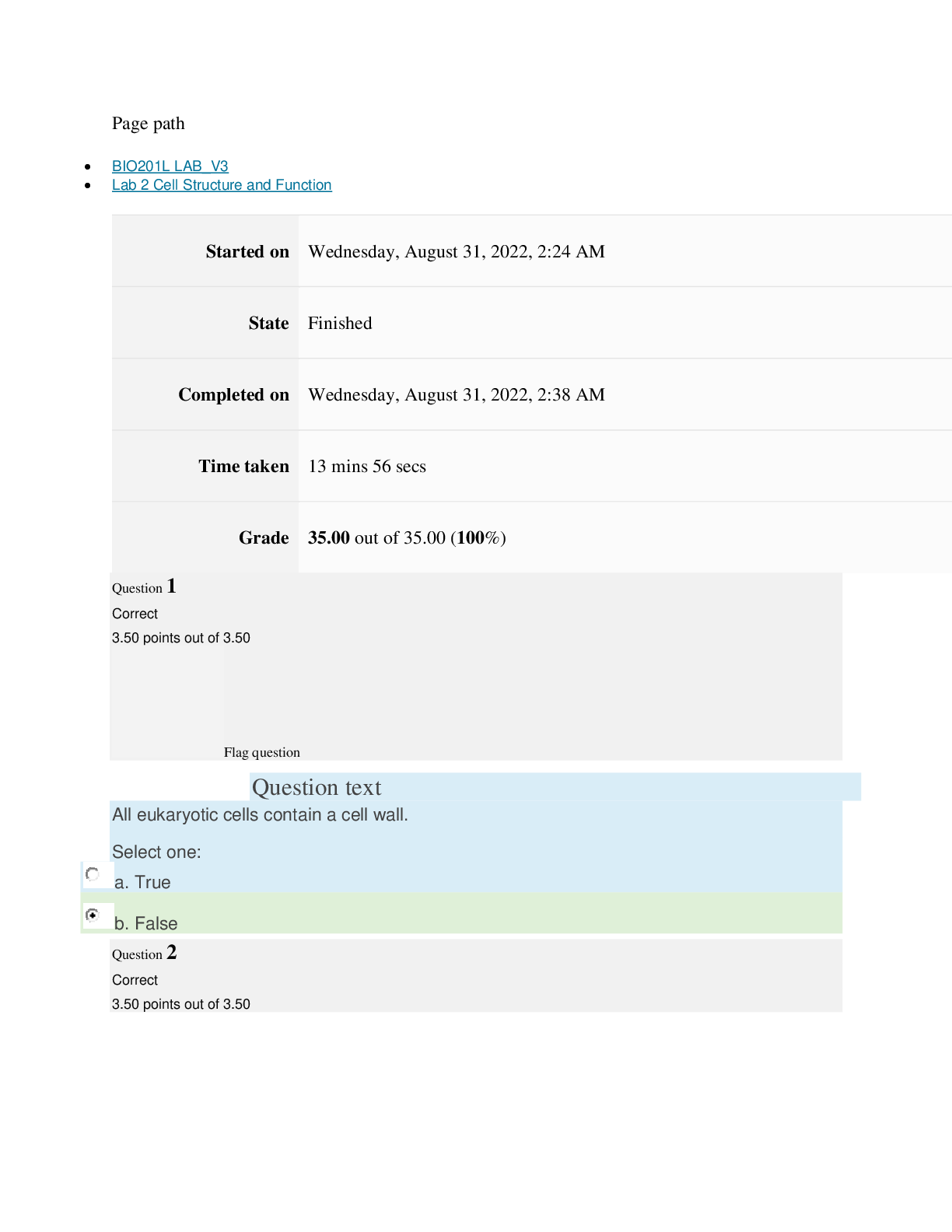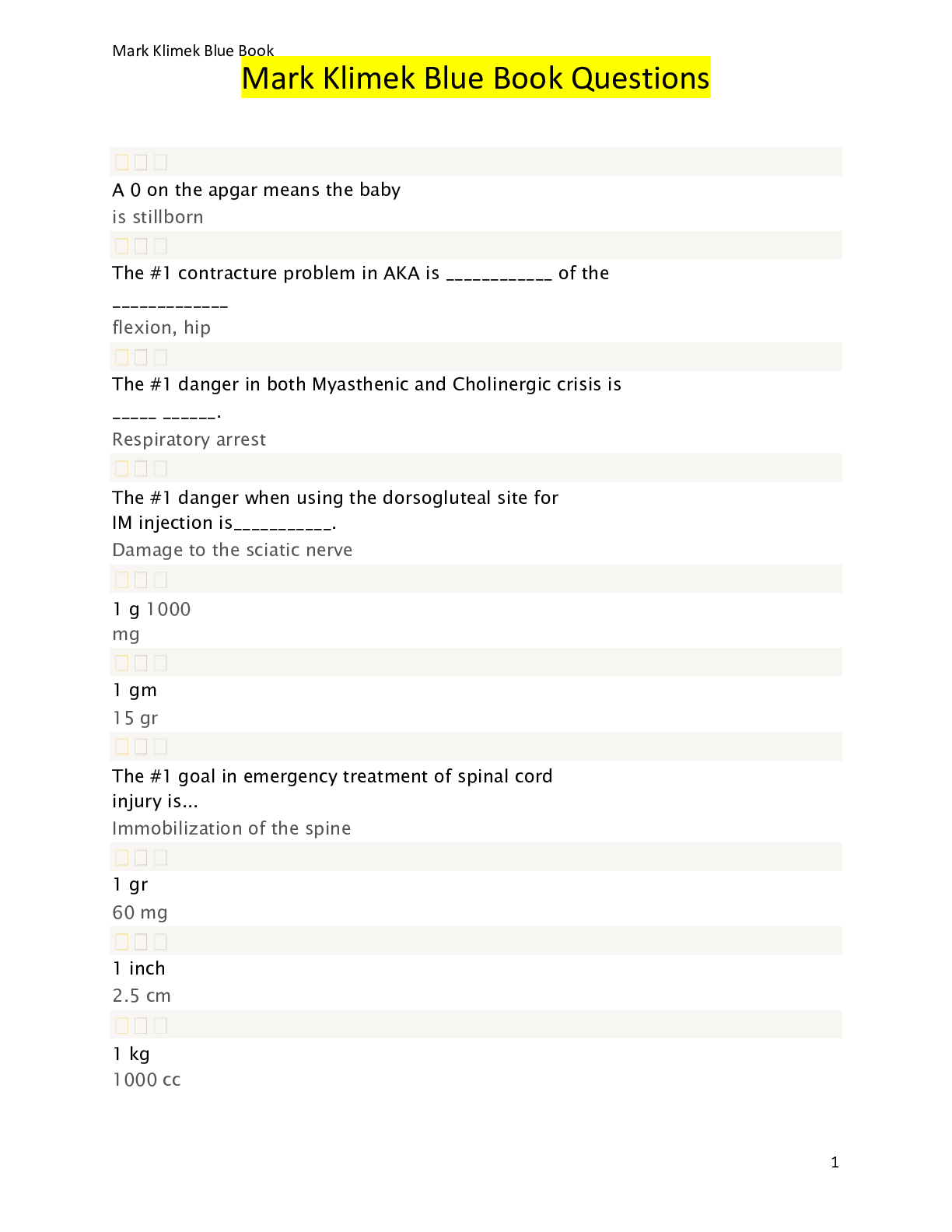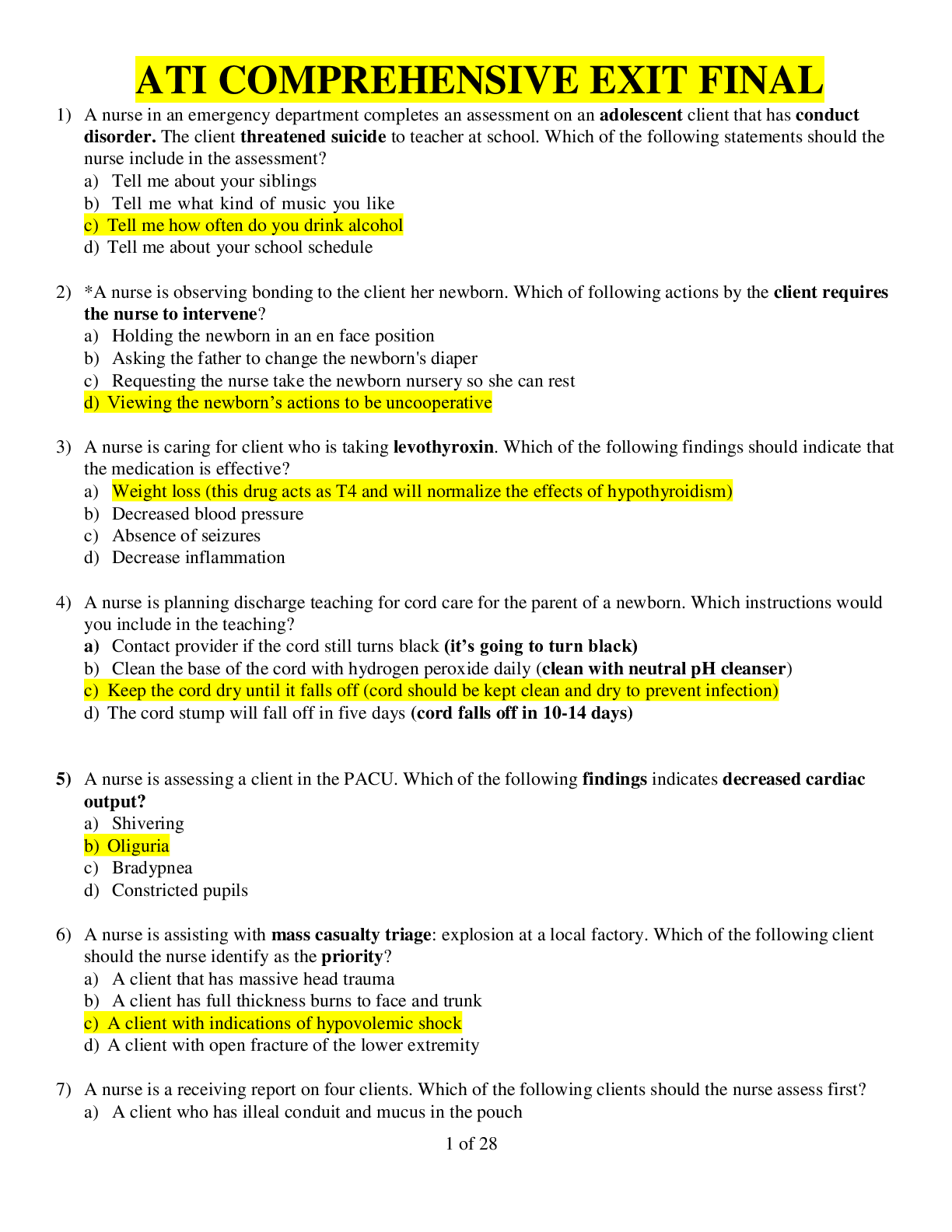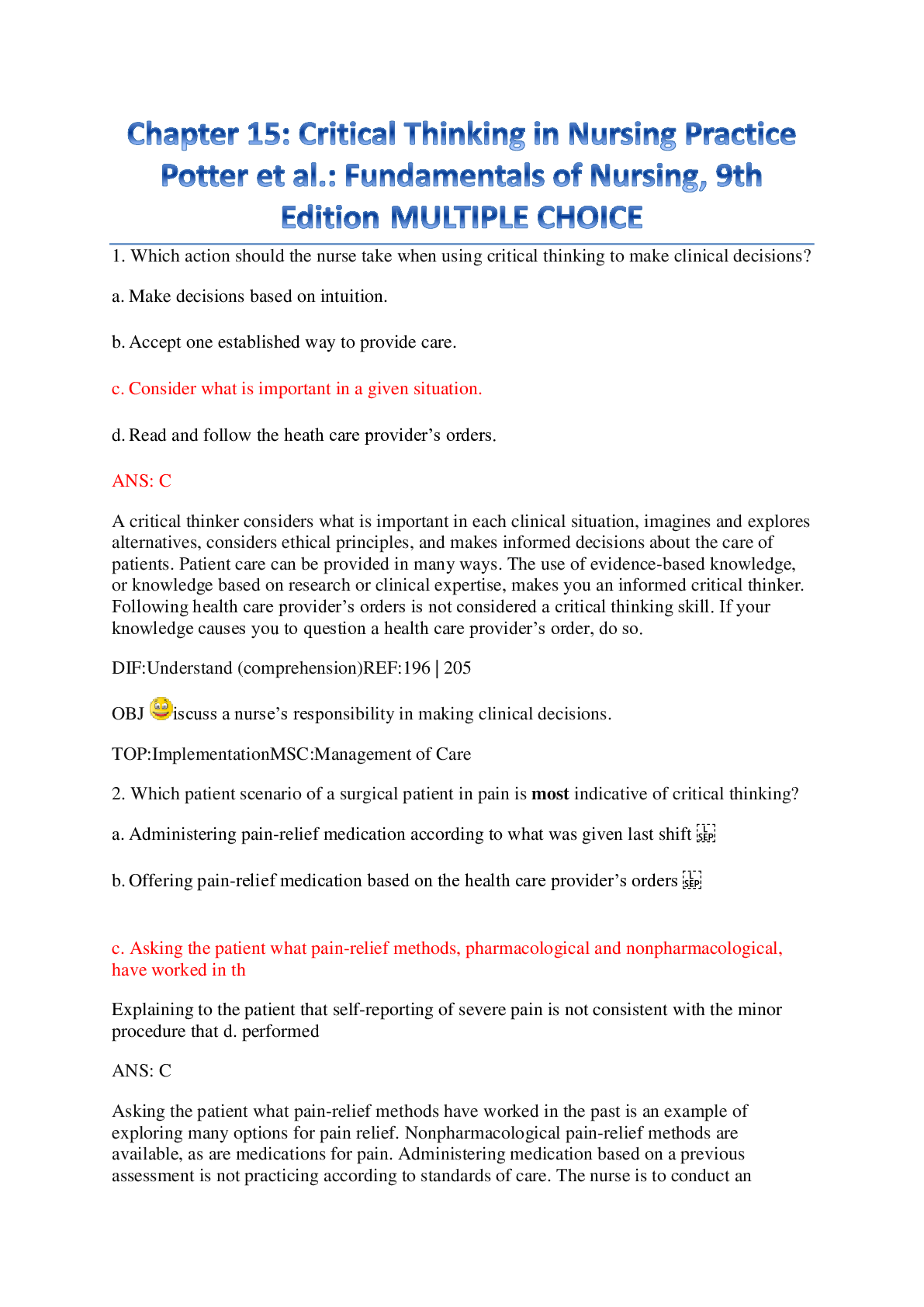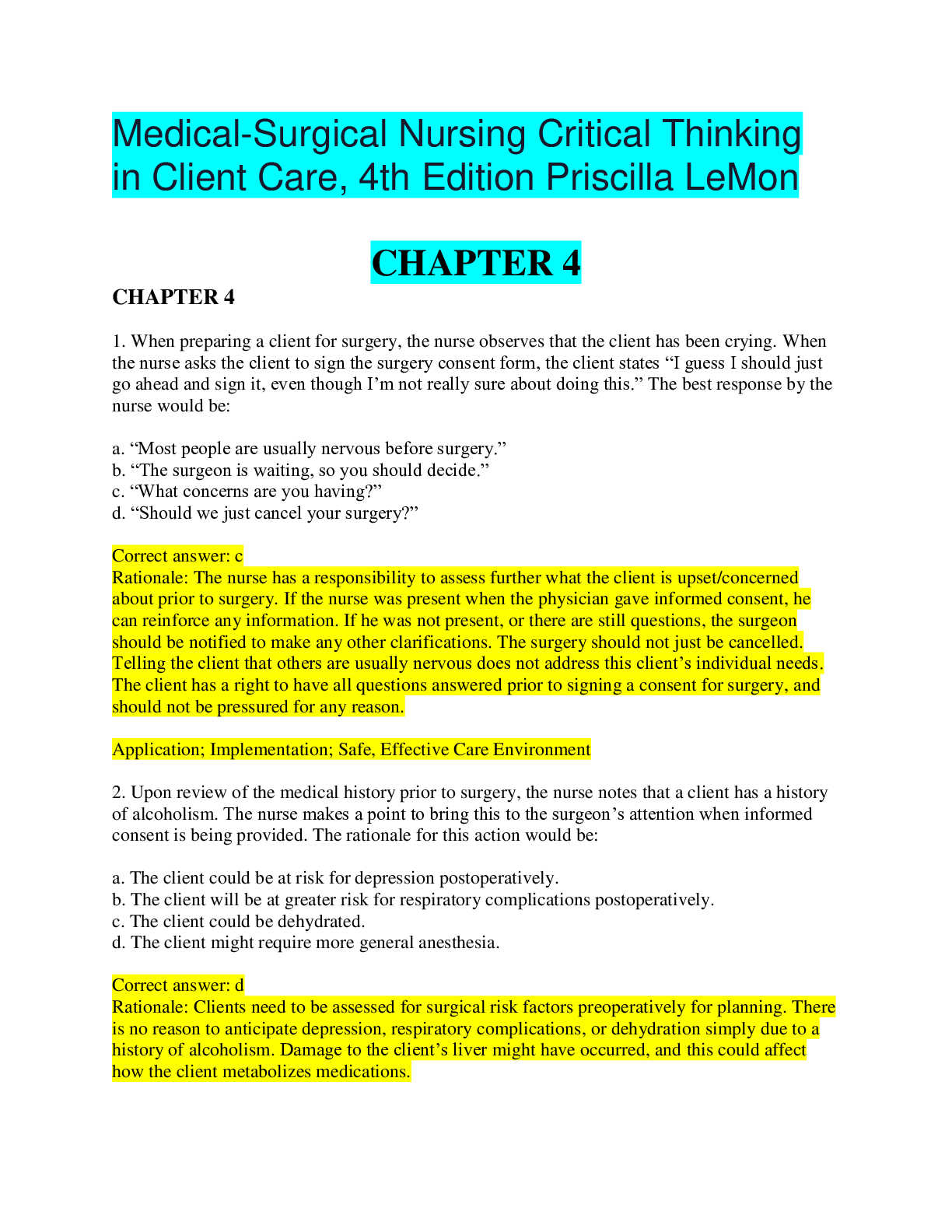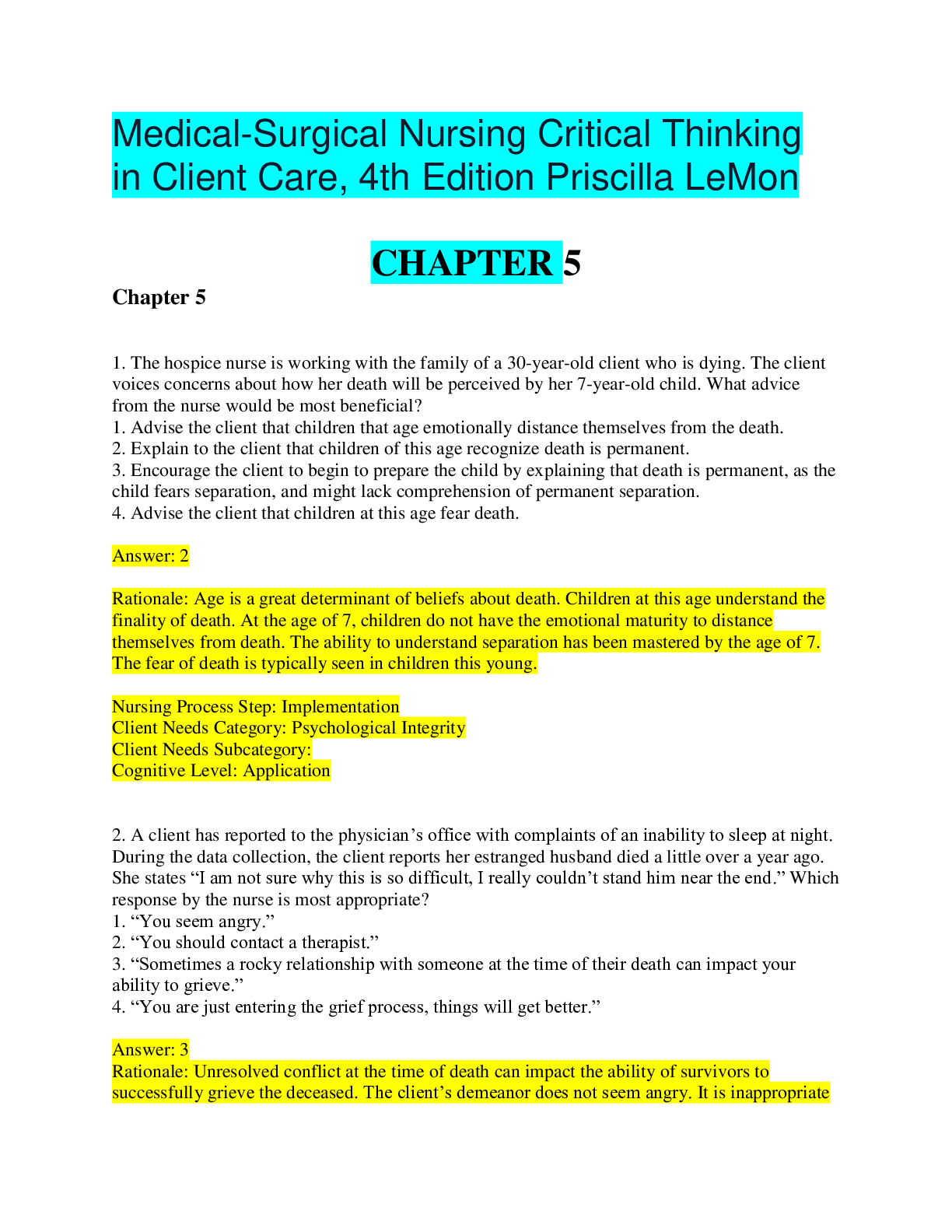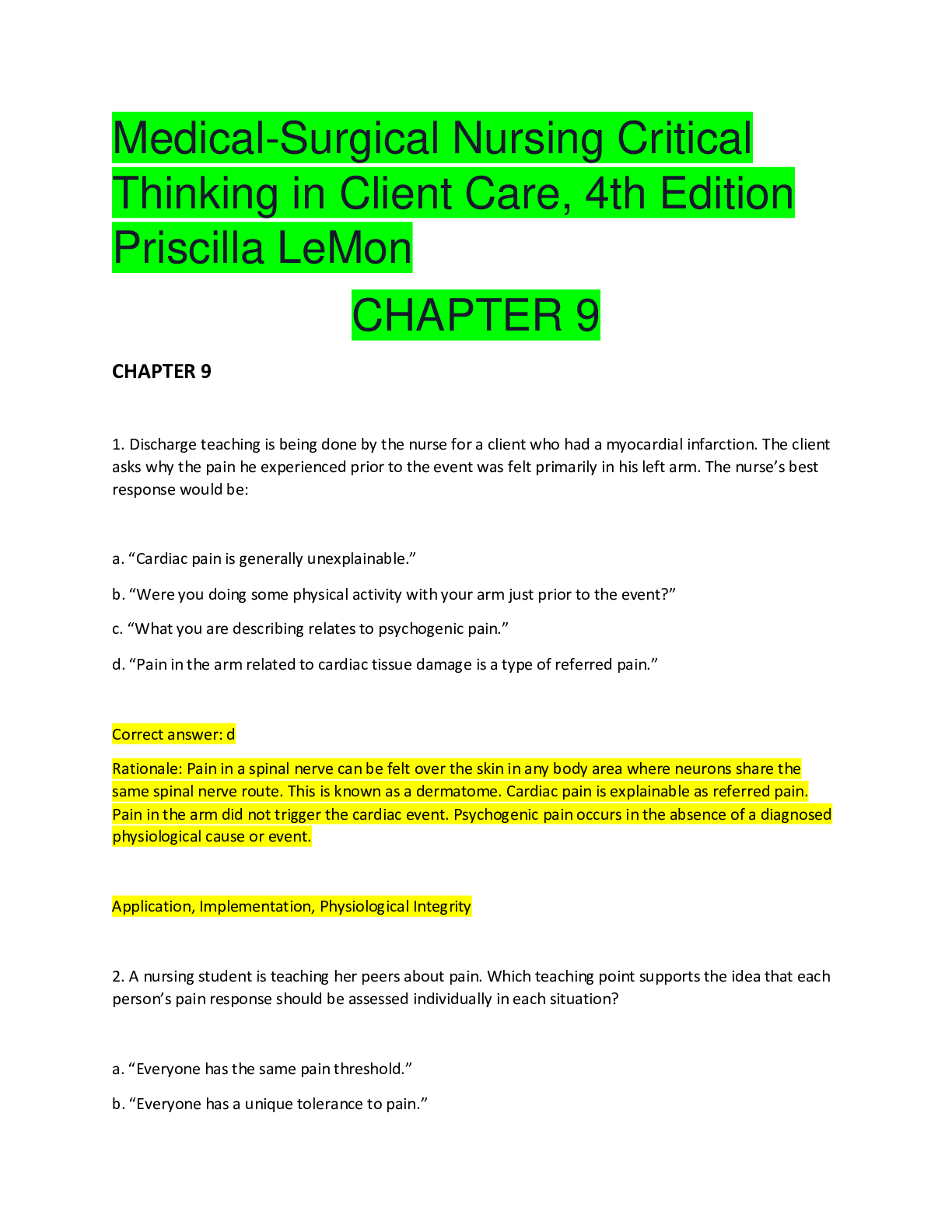Biology > QUESTIONS & ANSWERS > Fresno City College > BIOLOGY 102 > BIOLOGY 012, Medical-Surgical Nursing Critical Thinking in Clien (All)
Fresno City College > BIOLOGY 102 > BIOLOGY 012, Medical-Surgical Nursing Critical Thinking in Client Care, 4th Edition Priscilla LeMon CHAPTER 15 (QUESTIONS AND ALL CORRECT ANSWERS AND RATIONALE)
Document Content and Description Below
Medical-Surgical Nursing Critical Thinking in Client Care, 4th Edition Priscilla LeMon CHAPTER 15 Chapter 15 1. A nursing student is studying the functions of the skin. Which statement by the nur... sing student indicates the need for further teaching? Hint: Table 15-1 Functions of the Skin and Its Appendages Answer Choices: 1. “The epidermis protects tissues from physical, chemical, and biologic damage.” 2. “The dermis regulates body temperature by dilating and constricting capillaries.” 3. “The eccrine sweat glands regulate body heat by excretion of perspiration.” 4. “The apocrine sweat glands cushion the scalp and provide insulation in cold weather.” Cognitive Level: Analysis Objective: Describe the anatomy, physiology, and functions of the skin, hair, and nails. Strategy: Evaluate each statement to determine if it is correct. Eliminate correct statements. Identify the incorrect statement, since the question stem references the need for further teaching. 2. The nurse is caring for an African-American client who has a serum bilirubin of 6 mg/100 mL. What is the best way of assessing for changes in skin color in this client? Hint: Table 15-2 Skin Color Assessment Variations in People with Light and Dark Skin Answer Choices: 1. Assess the sclera. 2. Assess the palms of the hands. 3. Assess the fingernails. 4. Assess the mucous membranes. 3. The nurse is caring for a client with oculocutaneous albinism. Which statement by the nurse demonstrates a good understanding of this disorder? Hint: Genetic Considerations: Integumentary System Answer Choices: 1. “Oculocutaneous albinism causes hypopigmentation of the skin, hair, and eyes as a result of an inability to synthesize melanin.” 2. “Oculocutaneous albinism is characterized by elevated scars, has a familial tendency, and is most commonly found in African-Americans.” 3. “Oculocutaneous albinism is the sudden appearance of white patches on the skin, and has a familial tendency.” 4. “Oculocutaneous albinism is an autosomal-dominant inheritance disorder that causes hyperpigmentation of the skin, hair, and eyes.” Strategy: 4. A nursing student is performing a functional health pattern interview of a client. If the student needs to assess the health perception and health management of the client, which question by the nursing student is best? Hint: Functional Health Pattern Interview Answer Choices: 1. “Do you bruise easily?” 2. “How well do your cuts and scratches heal?” 3. “Do you have any allergies to foods, plants, or pets?” 4. “Have you noticed swelling around your eyes or ankles?” 5. A client presents to the physician’s office with a superficial lesion. The nurse understands that the client’s physician will need to perform a test to differentiate between an infectious and inflammatory lesion. Which test would best determine this? Hint: Diagnostic Tests of the Integumentary System Answer Choices: 1. Shave skin biopsy 2. Incisional skin biopsy 3. Punch skin biopsy 4. Excisional skin biopsy 6. A client has an area of rough, thickened, hardened epidermis. Which disorder could be the reason for this skin lesion? Hint: Secondary Skin Lesions Answer Choices: 1. Chronic dermatitis 2. Athlete’s foot 3. Earring piercing 4. Psoriasis 7. A client is being treated for an elevated, darkened area of excess scar tissue. A nurse is explaining the reason for this skin lesion to a nursing student. Which statement by the nursing student indicates that teaching has been effective? Hint: Secondary Skin Lesions Answer Choices: 1. “This scar was caused by the wearing away of the superficial epidermis, causing a moist, shallow depression.” 2. “This scar was caused by excessive collagen formation during healing.” 3. “This scar was caused by skin loss extending into the dermis or subcutaneous tissue.” 4. “This scar was caused by wasting of the skin due to loss of collagen.” 8. The nurse is assessing a geriatric client. Which age-related changes should the nurse expect to see in this client? Select all that apply. Hint: Table 15-3 Age-Related Skin Changes Answer Choices: 1. Dry skin 2. Perspiration 3. Double chin 4. Skin tears 5. Purpura 9. A nursing student is performing integumentary assessments on older adult clients. Which skin lesion would best name the client’s brown benign macule with a defined border? Hint: Box 15-1 Common Skin Lesions of Older Adults Answer Choices: 1. Keratoses 2. Angiomas 3. Lentigines 4. Telangiectases 10. The nurse is caring for a client with thinning of the nails. Which test result would most likely be the reason for this nail disorder? Hint: Integumentary Assessments Answer Choices: 1. A low pulse ox 2. A low hemoglobin 3. A low serum albumin 4. A low white blood cell count 11. The nurse is assessing a client admitted with heart failure exacerbation. The client has 3+ lower extremity edema. Which description most accurately describes this client’s edema? Hint: Integumentary Assessments Answer Choices: 1. Slight pitting, no obvious distortion 2. Deeper pit, no obvious distortion 3. Pit is obvious, extremities are swollen. 4. Pit remains with obvious distortion. Answer: 3 12. A nursing student is learning about integumentary changes in the elderly. Which change is expected in an older adult? Hint: Table 15-3 Age-Related Skin Changes Answer Choices: 1. A decrease in abdominal fat 2. An increase in perfusion 3. A decrease in vitamin D production 4. An increase in vasomotor response 13. A client is being seen for a problem with the eccrine sweat glands. Because of this structural problem, the nurse knows that which function will be impacted in this client? Hint: Table 15-1 Functions of the Skin and Its Appendages Answer Choices: 1. Body temperature regulation 2. Regulation of body heat by excretion of perspiration 3. Sebum secretion 4. Sexual scent gland 14. A nurse is performing an assessment of the client’s nails. Which assessment should be included in this examination? Select all that apply. Hint: Integumentary Assessment Answer Choices: 1. Inspect nail thickness. 2. Inspect nail color. 3. Inspect nail curvature. 4. Inspect for pitting. 5. Inspect for grooves. 15. A nurse is assessing a client whose lab values this morning include a sodium of 144 mEq/L, a potassium of 3.8 mEq/L, a hemoglobin of 8.4 g/dL, and a glucose of 105 mg/dL. Which assessment might correlate with these findings? Hint: Integumentary Assessments Answer Choices: 1. The nail plate is separate from the nailbed. 2. The nail folds are inflamed and swollen. 3. The nail is spoon-shaped. 4. The nail has a transverse groove. [Show More]
Last updated: 2 years ago
Preview 1 out of 13 pages
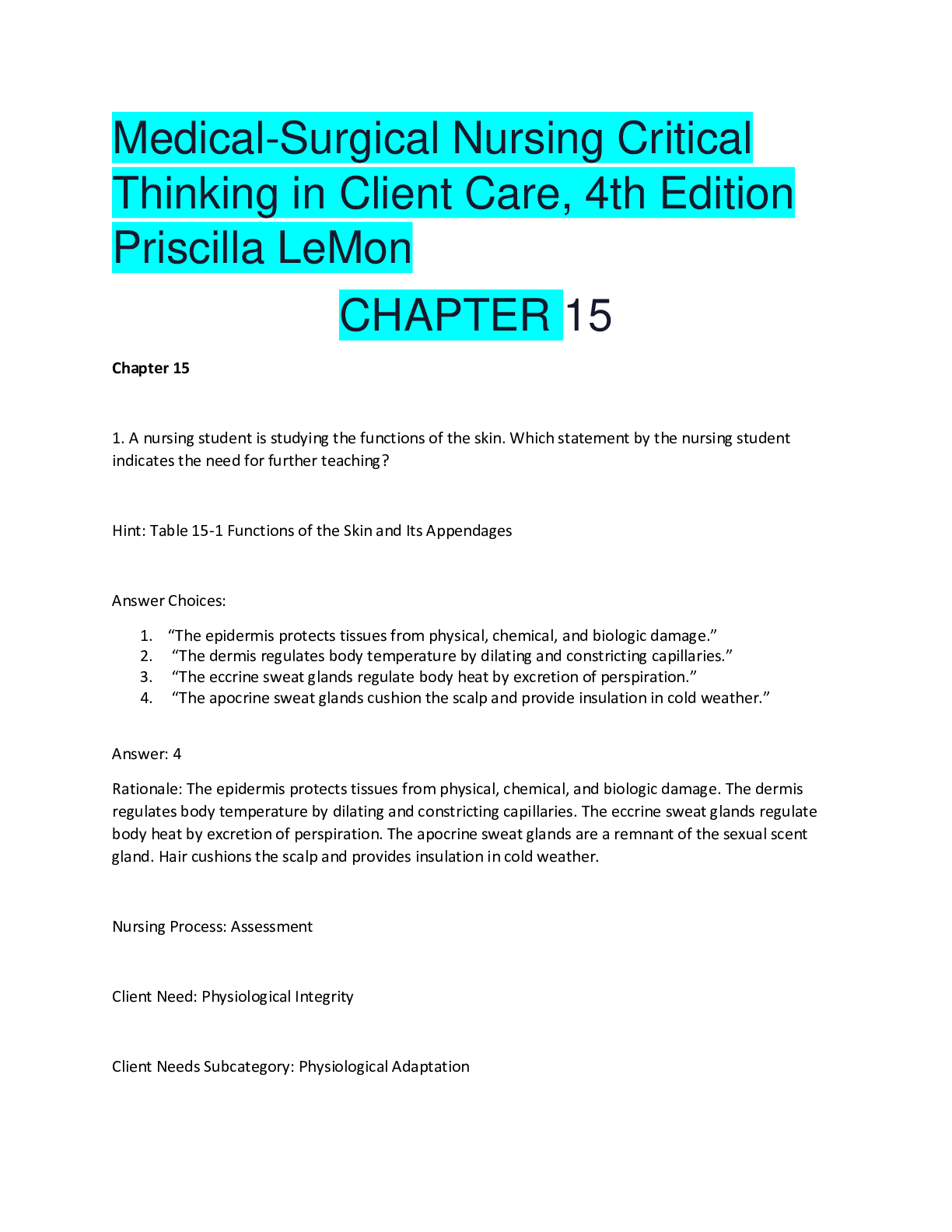
Buy this document to get the full access instantly
Instant Download Access after purchase
Buy NowInstant download
We Accept:

Reviews( 0 )
$4.00
Can't find what you want? Try our AI powered Search
Document information
Connected school, study & course
About the document
Uploaded On
Apr 13, 2020
Number of pages
13
Written in
Additional information
This document has been written for:
Uploaded
Apr 13, 2020
Downloads
0
Views
126

